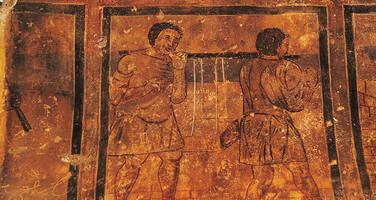Quseir Amra
Factors affecting the property in 1997*
- Management systems/ management plan
Factors* affecting the property identified in previous reports
- cracks in the rough-rendered surface of the vaults
- water infiltrations
- graffitis
- signs (for visitors) disfiguring the interior
- flooding (issue resolved)
International Assistance: requests for the property until 1997
Total amount approved : 20,000 USD
| 1995 | Urgent works on the site of Quseir Amra (Approved) | 20,000 USD |
Missions to the property until 1997**
Information presented to the Bureau of the World Heritage Committee in 1997
In 1995, the Chairperson of the Committee approved an emergency request for US$ 20,000 for protective work against flooding. This work, carried out in close collaboration with the Directorate of Antiquities of Jordan and the French Archaeological Institute for the Near East (IFAPO), has now been completed. It involved diverse cleaning operations, drainage, construction of embankments and canals to divert the water, as well as reinforcement and excavations in the nouria area where archaeological vestiges were found. Subsequent to this project, the French Embassy in Amman, the Directorate of Antiquities and the IFAPO completed a restoration project last December for the manege, wells, cistern and water supply system (saqiyya) in the Omayyades Baths.
Action Required
After having taken note of the report of the Secretariat on the site of Quseir Amra, the Bureau thanked the Jordanian authorities for their efforts, jointly with UNESCO and the Cultural Service of the French Embassy, to protect the site from flooding and to restore the manege and the cistern of the Omayyades Baths.
21st extraordinary session of the Bureau in 1997:
Satisfied with work undertaken to improve the visitors' centre with plans financed by France, the Bureau requested the Jordanian authorities to consider submitting a request for assistance under the World Heritage Fund as a contribution to the construction of the visitors' centre. Finally, the Bureau congratulates the Jordanian authorities on the results achieved at this site and recommends that all these efforts be integrated in a comprehensive plan for the management of the site which the Secretariat could help prepare.
Conservation issues presented to the World Heritage Committee in 1997
Further to the request put forward by the Bureau on improving visitor control mechanisms, the Secretariat has received from the French Cultural Attaché in Jordan the plans for a visitors' centre. These plans were financed by the French Embassy in the framework of co-operation established with UNESCO and have been approved by the Jordanian authorities.
Summary of the interventions
Decisions adopted by the Committee in 1997
21 BUR IV.B.45
Quseir Amra (Jordan)
After having taken note of the report of the Secretariat on the site of Quseir Amra, the Bureau thanked the Jordanian authorities for their efforts, jointly with UNESCO and the Cultural Service of the French Embassy, to protect the site from flooding and to restore the manège and the cistern of the Omayyades Baths. The Bureau recommended that the Jordanian authorities improve visitor control mechanisms to ensure a better protection of the wall paintings.
21 COM VII.C.55
Reports on the state of conservation of cultural properties noted by the Committee
VII.55 The Committee noted the decisions of the twenty-first extraordinary session of the Bureau on the following cultural properties as reflected in the report of the Bureau session, Working Documents WHC-97/CONF.208/4B Section III.C.c):
Joya de Ceren Archaeological Site (El Salvador)
Le Canal du Midi (France)
Mont-Saint-Michel and its Bay (France)
Ashanti Traditional Buildings (Ghana)
Maya Site of Copan (Honduras)
Agra Fort, Taj Mahal, Fatehpur Sikri (India)
Quseir Amra (Jordan)
Town of Luang Prabang (Lao People's Democratic Republic)
Pre-Hispanic City of Teotihuacan (Mexico)
Ilha de Mozambique (Mozambique)
Moenjodaro (Pakistan)
Baroque Churches of the Philippines (Philippines)
Old Town of Segovia and its Aqueduct (Spain)
Cultural World Heritage sites in Sri Lanka
Ancient City of Damascus (Syrian Arab Republic)
Historic Areas of Istanbul (Turkey)
Itchan Kala, Historic Centre of Bukhara (Uzbekistan)
Shibam and Zabid (Yemen).
The Bureau may wish to adopt the following text and transmit it to the Committee for noting:
"The Bureau requests the Jordanian authorities to consider submitting a request for assistance under the World Heritage Fund as a contribution to the construction of the visitors' centre. Finally, the Bureau congratulates the Jordanian authorities on the results achieved at this site and recommends that all these efforts be integrated in a comprehensive plan for the management of the site which the Secretariat could help prepare."
Documents examined by the Committee
21COM (1997)Exports
* :
The threats indicated are listed in alphabetical order; their order does not constitute a classification according to the importance of their impact on the property.
Furthermore, they are presented irrespective of the type of threat faced by the property, i.e. with specific and proven imminent danger (“ascertained danger”) or with threats which could have deleterious effects on the property’s Outstanding Universal Value (“potential danger”).
** : All mission reports are not always available electronically.


